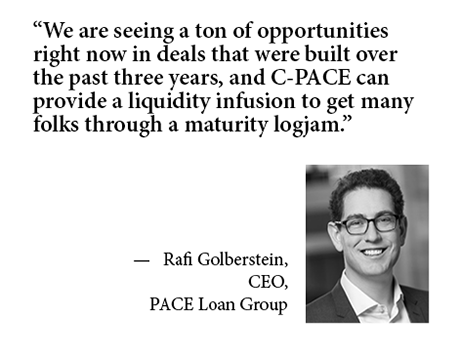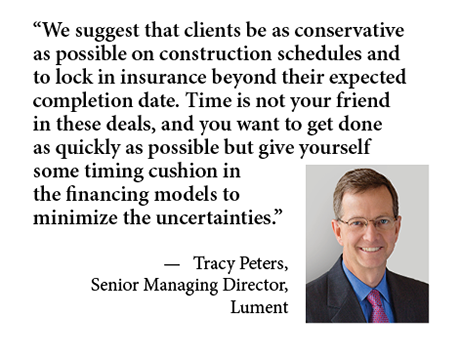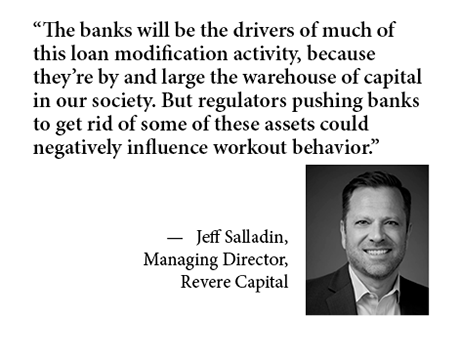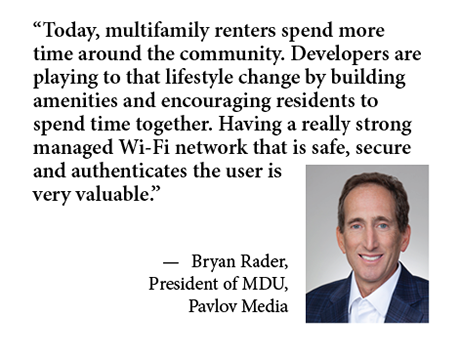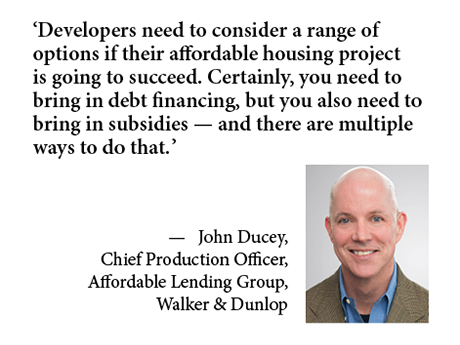The term “adaptive reuse” in real estate circles typically conjures images of repurposing old, obsolete commercial buildings. Meanwhile, academic buildings, administrative offices and other properties on college campuses rarely come to mind. But NAI has noted a growing need among higher learning institutions with vacant or underused assets, particularly as a result of growing online learning options, says Larry Gautier, senior vice president of NAI Miami | Fort Lauderdale. As a result, the brokerage is focused on finding solutions for schools. “NAI hasn’t historically been involved with higher institutions of learning — we’ve typically focused on conventional real estate transactions,” Gautier acknowledges. “But a few years ago, when students weren’t going in to class, colleges and universities were facing a challenge: what do you do with facilities — that were built for thousands of students — in a remote-learning setting? For many schools, remote learning is here to stay.” Options include leasing buildings to commercial users or entering a joint venture with, for example, an aerospace or engineering company for educational programs, he adds. Colleges that suddenly have vast unused parking lots could also enter into long-term leases with multifamily, office or mixed-use developers. “Our position is to help these schools create …
Content Partner
The spike in interest rates and the consequent disruption throughout real estate capital markets over the last 18 months is generating newfound interest in commercial property assessed clean energy (C-PACE) financing. The program, which emerged more than a decade ago, pays for building upgrades to improve energy and water efficiency as well as seismic resilience in new construction and rehabs. In cases where cost overruns, stabilization delays and declining values threaten the ability to refinance construction loans, developers are tapping C-PACE retroactively for a much-needed slug of so-called “rescue capital,” says Rafi Golberstein, CEO of the PACE Loan Group, a direct lender of C-PACE based in Minneapolis, Minn. Typically, developers are using the proceeds to pay down debt and fund reserves to secure loan extensions or modifications. “We are seeing a ton of opportunities right now in deals that were built over the past three years, and C-PACE can provide a liquidity infusion to get many folks through a maturity logjam,” he declares. “When confronted with other options, they’re going to prefer C-PACE all day long.” Cost-Effective Debt Indeed, the cost of those other options, such as mezzanine financing or preferred equity, can be upwards of 500 basis points higher …
AcquisitionsContent PartnerFeaturesLee & AssociatesMidwestMultifamilyNortheastOfficeRetailSoutheastTexasWestern
Is a Rebound in the Cards for Investment Sales Anytime Soon?
Would-be commercial real estate investors and sellers for the last several months have been waiting for a sign that the Federal Reserve has tamed inflation, therefore giving the central bank reason to officially end its tightening program. October’s better-than-expected consumer price index increase of 3.2 percent — versus the 3.3 percent consensus — may have delivered that signal. The futures markets immediately reduced the probability of a Fed interest rate hike in December to zero, with many capital markets analysts suggesting that it would begin to cut rates midway through 2024. But just an end to rate hikes could fuel investment sales activity, says Jeff Rinkov, CEO of Lee & Associates Commercial Real Estate Services. “Once investors see some positive sentiment from the Fed, I think they’ll start to get interested in deploying what we believe is an enormous amount of capital that has been waiting on the sidelines,” he explains. “I also think that’s when investors will be met by more accommodating sellers. At the moment, price discovery continues to be very challenging and is driving a sluggish transaction environment.” Crashing Sales Indeed, investment sales volume through three quarters of 2023 totaled $276.3 billion, a year-over-year decline of 55 …
Affordable HousingContent PartnerDevelopmentFeaturesLoansLumentMidwestNortheastSoutheastTexasWestern
How to Clear Affordable Housing’s Construction Financing Hurdle
Developers are finding it tougher than ever to finance affordable housing. And often, the biggest hurdle for the sector’s borrowers involves construction — either obtaining that initial loan at a manageable cost or qualifying for take-out financing after a protracted construction period — which has strained resources and delivery schedules for a number of developments. Limitations on rent increases make the industry especially vulnerable to rising costs, and expenses today have risen precipitously across the board. Rents have also grown, but not on pace with construction and operating costs driven up by inflation, wage pressures, soaring insurance premiums and a series of interest rate hikes, observes Tracy Peters, a senior managing director on Lument’s affordable housing production team. “Borrowers are squeezed by a number of things in this marketplace,” Peters says. “The fed funds rate climbing 5 percent over the last two years means the interest rates on construction loans have basically come up 5 percent or more over that time. Now folks who had budgeted for a much lower interest rate — if they are still in construction mode — are trying to figure out how to deal with these higher interest rates.” At the same time, the …
Following the financial markets crash 15 years ago, banks and other lenders began working with commercial real estate (CRE) borrowers who had run into trouble. Solutions included loan extensions, loan sales, recapitalizations and foreclosures. Today lenders are pulling out the playbook again. “We have seen a huge number of loan workout deals come across our desk,” says Jeff Salladin, a managing director with Dallas-based private debt fund Revere Capital. “Any lender that holds loans on their books is seeing the same thing.” Back in 2008, dodgy and highly leveraged residential and CRE loans — along with the emergence of exceedingly risky debt derivatives created by Wall Street — eventually crashed, causing the credit market to collapse. Today credit is still available, but the cost of it has spiked over the last 18 months. Consequently, many commercial properties owners have seen values plummet, making it difficult to find refinancing. The Federal Deposit Insurance Corp.’s (FDIC) imminent auction of Signature Bank’s $33 billion in commercial property loans and other assets is expected to attract bids as much as 40 percent below face value, according to The Wall Street Journal. That’s just the latest gloomy bellwether regarding CRE values and underscores the predicament …
Content PartnerDevelopmentFeaturesLeasing ActivityMidwestMultifamilyNortheastPavlov MediaSoutheastTexasWestern
Multifamily Operators Adopt Property-Wide Internet Access as New Standard Amenity
Multifamily residents want to take their internet connections with them beyond their unit’s four walls and throughout the complex. The National Multifamily Housing Council has found for years that 90 percent of renters say good internet access is a necessity. But the meaning of good connectivity has changed. “Ten, fifteen or twenty years ago, the most popular trend was cocooning — where people would go to work, come home and run into their apartment. They’d close the door, and you wouldn’t hear or see from them again until the next day,” says Bryan Rader, president of MDU at internet service provider Pavlov Media. “Today, multifamily renters spend more time around the community,” he continues. “Developers are playing to that lifestyle change by building amenities and encouraging residents to spend time together. Having a really strong managed Wi-Fi network that is safe, secure and authenticates the user is very valuable.” Put more simply, Wi-Fi within amenities is important to renters. Take fitness centers, for example. When was the last time you saw anyone on a treadmill without headphones relaying music from the internet through a phone or tablet? The move toward property-wide internet demand started in universities as students needed internet …
AcquisitionsContent PartnerDevelopmentFeaturesIndustrialLeasing ActivityLee & AssociatesMidwestMultifamilyNortheastOfficeRetail
Lee & Associates: Slowing Absorption, Rent Growth Put Brakes on New Development for Most Real Estate Types, Though Retail Sector Shines
Slower absorption and rent growth plagued industrial, office and multifamily asset classes across the United States in the third quarter, as outlined in Lee & Associates’ 2023 Q3 North America Market Report. Some regional exceptions were able to buck the overdevelopment trend, but retail was the only property type to avoid the quarter’s shift toward rising vacancy rates. High interest rates, slower rent growth and fear of overbuilding have contributed to lower construction starts in every sector. The full Lee & Associates report is available — including breakdowns of factors like detailed vacancy rates, inventory square footage, cap rates outlined city by city, market rents and more — here. The analysis below provides an overview of industrial, office, retail and multifamily real estate sectors alongside sector trends, economic background as well as geographic exceptions within each property type. Industrial Overview: Absorption Continues Slowing, Inventories to Spike Demand for industrial space remained positive in the United States in the third quarter, but growth this year has lost steam compared to strong net absorption totals of the last two years. U.S. net growth in the third quarter totaled 29.9 million square feet compared to 94 million square feet for the same period last year. …
Families searching for more space, in part as remote work options retain their hold on the workplace landscape, plus strong migration into the Southeast have helped fuel a robust single-family rental market, especially in Atlanta and other Georgia markets over the last several years. More recently, young renters pairing up to share the growing burden of housing costs, as well as would-be home buyers putting off a purchase because of higher interest rates, have also gravitated toward single-family rentals, says Troy Reynolds, a multifamily advisor with NAI G2 Commercial Real Estate, who has added single-family rentals to his business focus. Given the lack of housing supply in the Southeast, these conditions are likely to persist for the foreseeable future. As a result, a growing number of investors have been piling into the assets amid a multifamily investment market saturated with buyers and a consequent leap in prices over the past few years, he adds. “We just don’t have enough housing to meet all the demand, and we continue to see a mass exodus from other states into the Southeast, and particularly into Georgia,” Reynolds states. “So, we’re seeing a lot of younger as well as newer investment groups coming …
Today’s accelerating technology transformation is altering how the commercial real estate industry executes transactions and manages assets. “The amount of information that a multifamily borrower needs to submit and disclose has become more demanding over time,” says William (Bill) Hyman, a Lument senior managing director who oversees the firm’s strategic business technology transformation and conventional loan production. “That has made due diligence more complex and data intensive, and we wanted to create a more secure and expedient way to tackle that process.” Seeing this need, Lument responded by creating a suite of proprietary technology tools. Across the industry, the advent of online, friendlier multifamily loan application and servicing processes has not only eliminated the transfer of sensitive information through email by moving the processes to secure portals, but it has also streamlined common paper-based, time-consuming and burdensome tasks. That has translated into much speedier decisions about loans and responses to questions and requests. LeapOnline Beginnings Lument is a commercial real estate finance solutions provider based in New York that specializes in Fannie Mae, Freddie Mac, Federal Housing Administration and balance sheet lending. The company’s digital transformation began in 2017. At the time, the company saw the opportunity to better …
Affordable HousingContent PartnerDevelopmentFeaturesLoansMidwestMultifamilyNortheastSoutheastTexasWalker & DunlopWestern
How to Maximize Agency Financing for Affordable Housing
There are a variety of ways to build affordable housing, but implementing these strategies has become an increasingly difficult proposition in 2023. Affordable housing projects seem to face challenges on every front. Generally affordable housing developers will: Despite intensifying renter demand for new units, developers are struggling to make their projects financially feasible, says John Ducey, chief production officer in the affordable lending group at Walker & Dunlop. “Affordable housing developers are facing some of the toughest headwinds I’ve seen in more than 20 years in the industry,” Ducey says. “That means developers are forced to work harder than ever to structure deals that stretch scarce housing subsidies and maximize agency financing.” Challenging Conditions One impediment to affordable housing efforts is reduced future rent levels, related to area median income (AMI) caps the Department of Housing and Urban Development (HUD) imposed recently on LIHTC properties in many markets in the United States. The unexpectedly restrictive caps forced developers to slash revenue projections, scuttling some transactions and forcing many loan applicants to renegotiate or seek alternative financing to salvage deals. On the expense side, inflation and the labor crunch continue to drive up costs for new construction, renovation of older affordable …



